Neck pain, also known as cervicalgia, is a common problem, with two-thirds of the population experiencing it at some point in their lives. Although it is felt in the neck, the cause can be due to various other spinal issues. Neck pain can arise from muscular tightness in both the neck and upper back, or from pinching of the nerves.
When neck pain becomes serious, it may be due to conditions like a cervical artery dissection. This type of pain is unusual, persistent, and often accompanies a severe headache. Pain from a carotid artery tear can spread along the side of the neck and up towards the outer corner of the eye, while a vertebral artery tear may feel like something sharp is stuck at the base of the skull.
The sources of neck pain can vary. Most acute pain relates to tissue injury and is termed nociceptive pain. However, chronic pain, referred to as neuropathic pain, might start with a damaged or irritated nerve, but the pain signals often originate in the brain.
Surprisingly, sleeping positions can also cause neck pain. Sleeping on the stomach, for instance, requires rotating the head to the side. Similarly, sleeping on the side without proper support can push the neck toward the shoulder, leading to muscle strain and pain.
Temporomandibular disorders (TMD) are another potential cause of neck pain. These disorders involve the jaw muscles, temporomandibular joints, and nerves linked to chronic facial pain, often resulting from jaw strain, teeth grinding, injury, or arthritis.
Chronic head and neck muscle pain can manifest as Myalgia or Myofascial Pain. Myalgia is localized pain in a specific muscle, whereas Myofascial Pain spreads to other muscles due to trigger points in the affected muscle.
Neck and arm pain, often described as burning or sharp, can be exacerbated by certain neck movements. Accompanying symptoms may include tingling, weakness in the arm, shoulder, or hand, and loss of sensation.
Despite these challenges, there are effective ways to soothe a sore neck. Treatment options focus on relieving pain, restoring function, and preventing further injury.
Ear infections can also contribute to neck pain. Warm compresses, pain medications, and topical numbing eardrops can lessen the pain associated with ear infections. In chronic cases, surgical placement of ear tubes may be necessary.

Understanding the many causes and treatment options for neck pain is essential for effective pain management and recovery.
Neck pain |
When a pain in the neck is serious |
What could cause my persistent neck pain? |
Surprising causes of neck pain |
Temporomandibular Disorders (TMD) |
Chronic head and neck muscle pain |
Neck & Arm Pain |
How to soothe a sore neck |
Common ear infection questions


